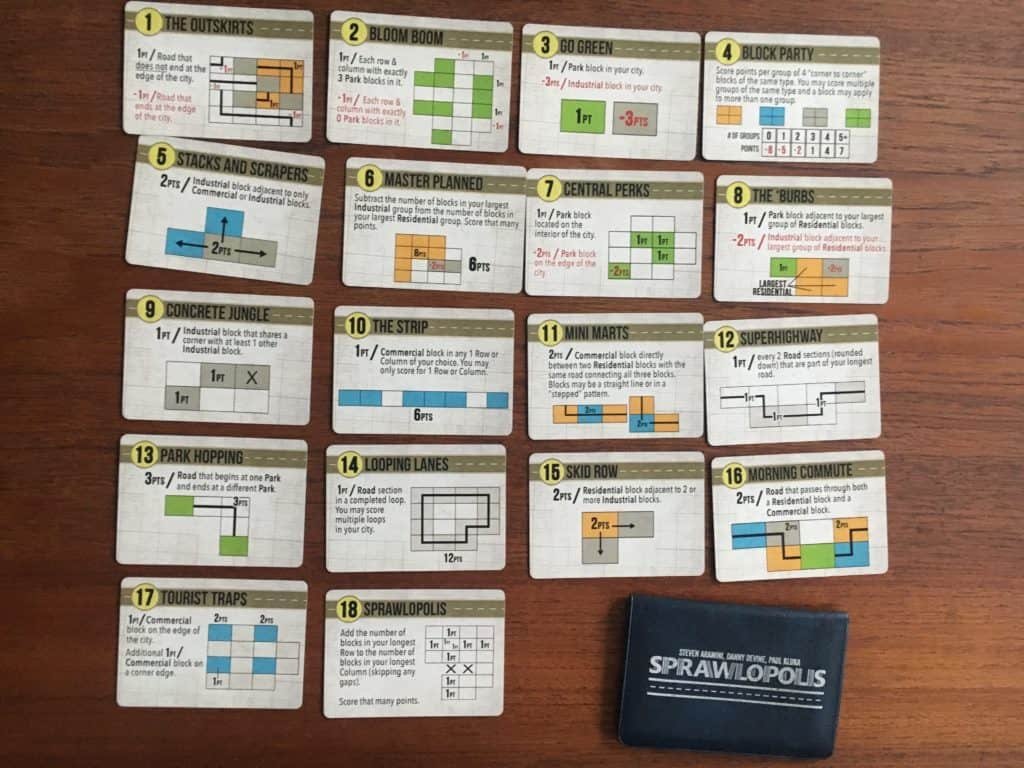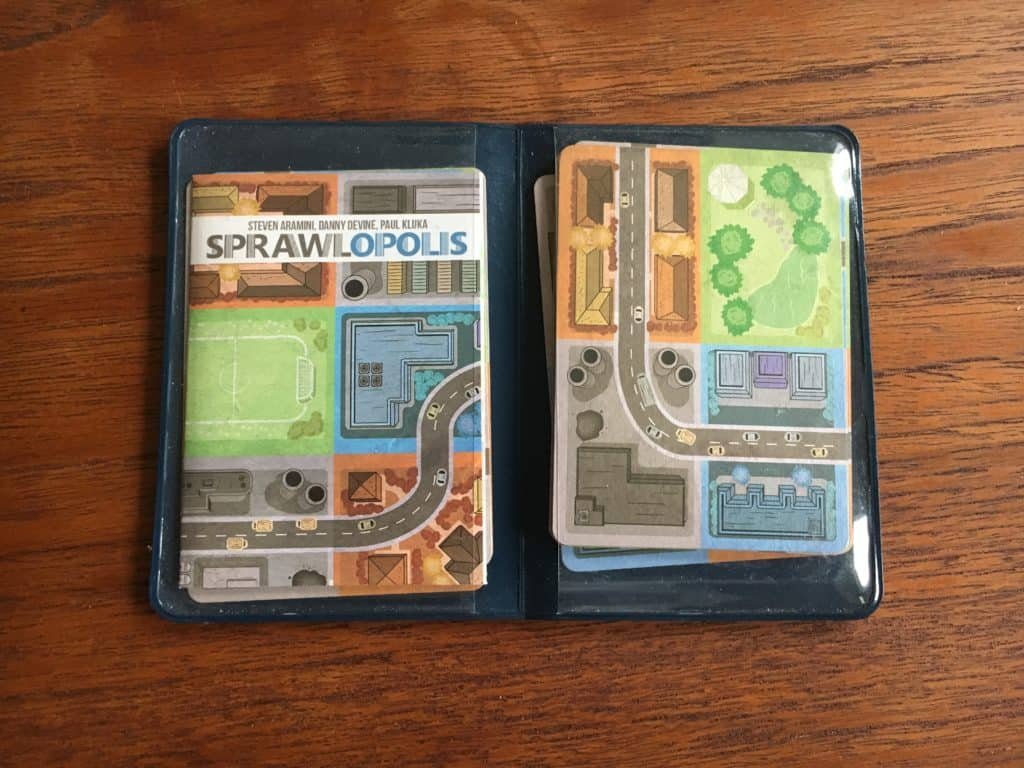Sprawlopolis is a game that I expected to like. Like any solo game, I expected it to challenge me. I expected it would be worth carrying around for a week to kill downtime in waiting rooms and break out at bars. My expectations were higher than for any other microgame I’ve played (and I love the microgame gimmick), and it still blew me away. How can such a small game be so good? Keep reading my Sprawlopolis review and find out.
To summarize the game, I’d say it’s a very thinky, thinly-themed city-building game, that’s best played solo, that, if you are like me, you will end up carrying around with you everywhere you go for months.

Sprawlopolis Review of Gameplay
So in this game, you have 18 two sided cards. On one side, there is a scoring condition. On the other, there is a road passing through a quadrant of city blocks of four types: industrial, residential, commercial and park. To setup a game, you choose 3 cards at random to act as the scoring conditions, shuffle the rest and draw a hand of 3 cards.
Now, you place a blocks. They can overlap in any way you’d like, as long as both cards remain horizontal and the new card is placed on top. You place a block, draw a card, and repeat until every card has been played. Then you score. That’s it.
You score:
- One point for each block in your largest cluster of each color.
- You score for your 3 scoring conditions drawn at the beginning of the game.
- And finally, you lose one point for every road, punishing you for failing to connect your roads together.
You might be mistaken to think a simple game that is this small would lack replayability, that games would start to feel samey after a few plays. That couldn’t be further from the truth. Between the 18 different scoring conditions (making over 800 unique combinations of 3), the game can feel so drastically different.
In some games, you build a compact city, scarcely 3 cards wide, with every card overlapping with 5 others, while in other games you sprawl out as large as you can, sometimes in a single long row just a few blocks tall, and sometimes in a large stairstepping rectangular shape, where cards scarcely overlap. The game never lets you even consider the same strategy in any two consecutive games, since every scoring condition can change your strategy so considerably. One game might be all about covering industrial blocks and getting the biggest possible park block, and the next might be about making the longest road you can, mechanics that feel different enough that I’d believe you if you told me they were parts of different games.
The only element that remains true to the game’s scoring in every permutation is scoring for you largest cluster of matching block types, but even that will occasionally score you 12 when you deem it important, and 3 in games where you calculate more lucrative scoring deals.
That said, this game really shines as you first discover how wildly different these patterns can be, when all the scoring conditions are novel, and you have no idea how to approach them. As you play more, it becomes less of a strategic thinking challenge, and more of a tactical slog.
And even worse, the game is full of anti-scoring-patterns, scoring conditions that reward you for goals in direct opposition. You might not even want to play those games, as it feels less about finding the balance between those two conditions and more about getting your guaranteed loss over with. To make matters worse, some cards are always in scoring conflict with the base rules, and will rarely get you as many points as they lose you. It doesn’t feel unbalanced, but it does feel bad.

Difficulty
This game can be difficult. It can even feel mean as you get to the end of a game, and discover that you lost ten points for roads that lead nowhere, and another 6 points for messing up one of the scoring cards, (the scoring cards often come with point scoring conditions paired with point losing conditions in a system that seems brilliant on paper, yet definitely one that can be super punishing).
On the hard difficulty, I can only win just under half the time, and since overanalyzing games like this is my jam, that makes this game feel like an outlier to me. It is definitely hard. And it’s not because the game is overly random, or because I feel there is something unfair going on. Practicing with one set of scoring cards won’t necessarily make you better at scoring with another set, or make you more informed about what works or doesn’t. In a way, this game feels like it has a skill plateau, where, after I learn the different patterns that different cards call for, I simply don’t know how to get better. Now, for many players, that won’t be an issue. I’m not sure if that’s even a real issue for me, I do love this game.
That being said, for the learning curve it does have, it’s excellent. You will probably learn things about the game that significantly changes how you approach it as you play it more. And unlike other games with learning curves, you always have an idea what to do in the early games too.
For example, as you play one game, you might realize how you could be more aggressively covering roads in every game where not all the block colors matter as much, or how you can just leave huge gaps in your city that your initial instincts were to fill in.

To Microgame or not to Microgame?
All in all, the best argument I’ve heard against microgames it that they typically suffer for being so small. These games frequently could be greatly enhanced by having 15 more cards, or by resource tokens, or a plethora of improvements that cannot fit in tiny plastic wallets or mint tins or banana socks, or whatever publishers are jamming board games into these days. However, gameplay-wise, this game does not suffer at all for being so small. In fact, If it were much bigger, I think it’d lose some of the elegance.
The only two things that I think a larger size would improve. The first would be the rules pamphlet. While the game certainly is elegant, and I wouldn’t call it difficult to learn, the rules pamphlet would be significantly improved by explaining the different scoring conditions, and clarifying a few things. The second would be a scoring notepad. The game might ask you to add up 11 numbers at the end of the game. A place to write them down would be great.

Solo or Multiplayer
Now, at the beginning of the review, I said this was best played as a solo game. It’s not that the multiplayer rules aren’t good, I think they’re fine, pretty clever, not fiddly. In multiplayer, the game becomes a co-op, where everyone works on the city together.
But the game is a little too puzzley for someone to easily explain their plans to their teammates, and a little too abstract for there to be any type of social element to it. If someone wanted to help a teammate with their turn, their first instinct might be to take that players cards and start rotating them, puzzling out where they might fit silently in their head, while the teammate silently waits to get their cards back to play their turn. It’s just not an easy puzzle to solve with others, and certainly not one that creates any fun type of social dynamic between the players. It’s not that players can’t make it work and have fun despite this, but it almost feels like it works in spite of the game.
But as a solo game, this truly shines.
This game uses the win-lose system, where hitting a point threshold lets you win, but does not rank how well you won, or give you a goal to beat for next time. It does have 3 levels of difficulty: easy (where you don’t lose points for roads), medium (the default), and hard (where only your largest cluster of blocks of a color will score). Between the scaling, and how hard hard can be, I think the system works.

Aesthetics
The components of the game are pretty good. The cards are nice stock, linen finished. The rules pamphlet fine: it’s so thin you only have to read it once and will never reference it again. I don’t like the plastic wallet at all, but that is what I signed up for. It is exactly as nice as you imagine it is. All in all, it might be a blessing, since this is a game I do not fear shoving in my pocket or letting it fall to the bottom of my backpack.
The graphic design for the game leaves a lot to be desired, but the art is nice. The variety of different permutations of each type of city block is a charming touch. It’s a little bland, but practical.
This game has a surprisingly nice table presence too. How the cards overlap just creates interesting shapes and contrast. This is a rare card game where you’d want to check out what’s going on, simply because of how weird that pile of cards is.

Official Serious Rankings
Back Pocket feel: 8/10
Front Pocket feel: 6/10
Plastic Wallet: Spill Resistant at bars
Shade of Park Green: 10/10
The bartender assuming you’re about to buy another drink because you pulled out a wallet at a bar: 4/10, not enough social skills.
The Reaction of your non-gamer friends when they realize board games are now technically an invasive species: 10/10


